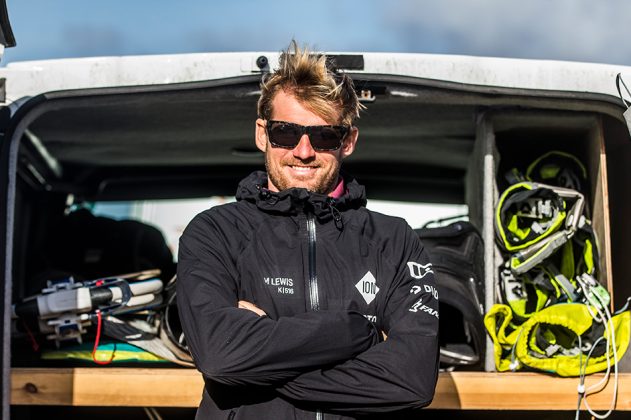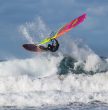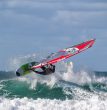From cross-off to dead onshore, competing on the British Wavesailing Association tour can take in all the conditions a UK wavesailor can expect to face on home shores. The pros have to be equipped for all conditions and all weathers; so how do they plan, choose and tune their quivers – John Carter investigates.
Words James Cox, Adam Lewis, Ben Proffitt, Andy Chambers, Phil Horrocks, Andy King & Timo Mullen. // Photos John Carter
ADAM LEWIS
I have a set of 3 Fanatic Stubby’s, the 94 is a prototype and then I have an 88 and an 82. I generally use these most of the time unless the waves are properly cooking or it’s really windy. If it’s really windy or fast and hollow waves I’ve got a Grip 82 with a quad set that I use, but in the UK that’s quite rare. I do normally have a spare 82 stubby in the van also just in case.
For sails I have a set of Duotone Super Hero’s, 5.3 all the way down to 3.4 in roughly .3 increments. I have a few spares in the key sizes too in case something gets broken mid-heat, I’ve learnt that the hard way! Planning my quiver is pretty easy as generally I choose the boards I get on with the most, boards that are a little better upwind or faster onto the plane. I normally take a slightly bigger board to compete on compared to if I was going to free sail, nothing is worse than bogging around mid-heat. Sail and rig wise I always like to be able to rig pretty much every sail, so I have a lot of masts and extensions.
Again on the day I normally would edge on the side of very powered up to compete, that extra power can give the moves or waves an extra dynamism that can help when being judged.
Tuning wise most of the time I seem to use thrusters, especially in the UK where the waves are slower and the wind is gusty, even on the stronger days. I don’t tend to change the front fin settings, but I do tend to move the rear fin/fins further back by about 5 mm if the waves are bigger or it’s more side off. Generally as I said I use thrusters, but I’m getting slowly back into quads, but only if it’s fast down the line waves or if it’s really windy, 3.7 or 3.4, otherwise I’d almost always choose thruster. I use K4’s mostly, a Scorcher rear and Ezzy or Shark fronts.
For tuning the rigs, I use pretty standard settings, maybe a touch fuller but still in the recommended rigging range. For windy down-the-line I put on a bit more downhaul so the sail is extra light in my hands, but only when it’s howling.
My other top tip would be to take two wetsuits if you have them, so if you have a gap between heats you can get clothes on, warm up and put on a dry warm suit after! That increases my motivation levels by 1000%. I think that’s it…now you know all my secrets!
“I normally would edge on the side of very powered up to compete”
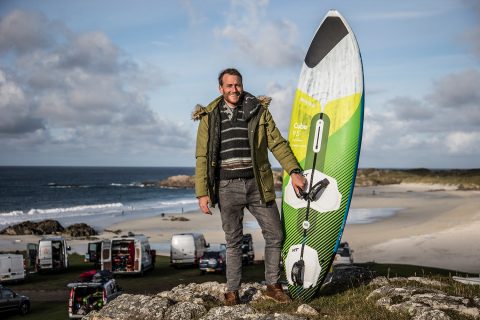
JAMES COX
I use Quatro Cube 86 and Cube 95 litre wave boards and Ezzy Elite 3.8, 4.2, 4.7 and 5.3 wave sails. For masts I have two sets of 400 and 370 and one 340. My larger sails take combinations of the 400 and 370, hence why having two sets is useful. Also it’s really important to have backups in case the waves get bigger. Even though Ezzy masts are the strongest I’ve ever known. For booms I’ve got two fairly old aluminium 211 (that’s the brand name) booms. That’s all I use. They seem solid. I’d love the opportunity to get carbon booms but I’ve always prioritised other gear due to shortage of funds. Maybe there is a sponsor out there looking for someone like the 2018 Cornwall Wave Classic Pro Champion to represent them?
My boards are quads to give me good boost and control in take-offs on jumps and also the boards provide goody snappy turning capabilities for everything from cross-offshore winds to onshore. Bear in mind I spend the majority of my time windsurfing in onshore winds and this setup works particularly well for that. Worth noting I also do love beautifully tight rail turns. Elites are the 4 batten wave sails from Ezzy Sails. Takas, the 3 1/2 batten sails, are also an option for me and I have had great results in the past, but I like the powered up feel of the Elites for extra height when jumping. I still have some moderate freestyle aspirations also which suit the Elites better in my opinion. They also work great for wave riding and have guided me through my first wave 360s and plenty of takas so I am very happy with these. My tuning for competition is probably quite basic compared to others in the pro fleets. At the moment I am limited to only be able to rig up two full sets of kit. This is probably a limiting factor for me due to wind shifts and the need to sometimes re-rig sails, but it hasn’t
really affected me too much. Generally speaking by tuning my sails alone I can get away without having to re-rig most of the time. Adjusting outhaul on the Elite’s can greatly change the pull of the sail. They are hugely versatile in terms of wind range capabilities. So a quick tug of the outhaul on the beach can keep me from frantically re-rigging. Also if I’m a little unsure of which size sails to rig my rule of thumb is to always rig bigger because planing in heats is a pre-requisite for scoring points.
I use K4 fins and in my 86 litre I have Shark fronts and Flex rears. In the 95 litre I use Ezzy fronts and Stubby rears. I try to go as small as possible on all sets. I don’t do as much configuration testing as I probably should, generally I am very impatient when at the beach and normally distracted when off the beach! Recently I’ve lowered my boom height which I believe has helped with wave riding but possibly had an adverse effect with one-handed jumping. My mastfoot sort of sits between a half and one third from the back depending on how windy it gets. Just writing this, I feel like I need someone to sit me down in a classroom and go through it all with a blackboard and chalk, but at the end of the day when I hit the water it seems to all work so sweetly I don’t ask too many questions and concentrate on having fun.
Wind angle adjustments are pretty much non-existent for me, but I look forward to stealing some knowledge from the others when I read what they say. I try and go with my smaller board simply because it is slightly less size to throw around on landing jumps and I’m quite nimble when it comes to float and ride. Generally I go for a smaller board for cross-off to side-shore, then go bigger board as the wind gets more onshore. If I can get away with a smaller board I will.
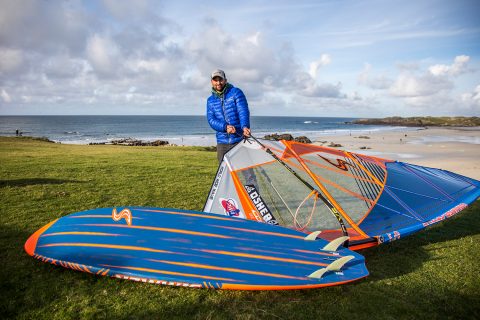
BEN PROFFITT
For boards, I have a Simmer Quantum 80, Simmer Quantum 90 and proto Flywave 78. I mostly use the Quantums for everything and set them up as quads. For a UK contest I like to have 3.4 all the way up to 5.6 in sails. In the Simmer Style Black Tips that is 3.4, 3.7, 4.2, 4.7, 5.0, 5.3 and I also have a 5.6 Icon which rigs on a 400 mast.
Most of my boards have five boxes so you can set them up as a thruster or quad. I like the quad setup on the Quantum’s; they are great versatile boards, I know them well and they cover me for everything. I feel comfortable on them and they have not changed too much over the last few years.
In the UK at a contest the problem most people have is that they don’t have enough masts and booms to rig multiple sails. I have a lot of booms, masts and extensions, so I can have five or six sails all ready to go. In locations like Tiree or Cornwall the wind can change from 3.7 to 5.3 in a day. You need to be prepared, there is no getting away from it. I am lucky with my boards because I sail them in down-the-line, cross-shore and cross-on, I like to keep it simple and that takes away any complicated decisions on what board to use in what.
“You need to be prepared, there is no getting away from it.”
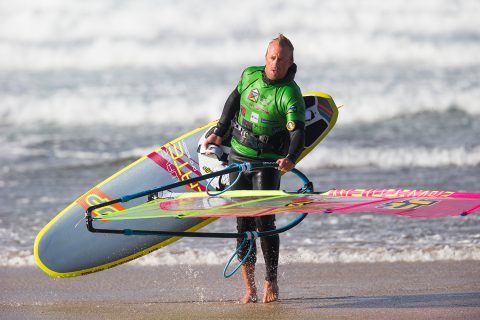
ANDY CHAMBERS
For boards I have a JP Wave Slate 87, JP Ultimate Wave 83 and JP Ultimate Wave 88 and NeilPryde Combat sails in 3.7, 4.0, 4.5, 5.0 and 5.3. My wave quiver covers me for all conditions so I just make sure I pack all of it into the van when I head to any wave event. In the UK we get such a variety of conditions and having the right setup makes all the difference. I use the NeilPryde Combats because they have such a large wind range I can cover all wind strengths that we compete in with less sails and makes sail sizing decisions a lot less stressful. I always rig at least three sails depending on the forecast and wind strength at the time and due to the great tuning range they have it makes life simple. One less thing to worry about rather than having six or more sails in 0.2 or 0.3 increments rigged up and not being able to work out which one to use! For boards I usually see how big the waves are and what direction the wind is. As soon as it is more onshore and anything from 4.0 to 5.3 weather I use the Slate 87, it is the most versatile board I have ever used. It’s so fast and quick to get around when the conditions are messy and more onshore. As soon as the wind is more side/side off or it gets mega windy I switch to the Ultimate Wave boards; they are so radical in the turns. You can really get a good fast bottom turn and roundhouse top turn no matter how windy it gets. For a Quad they are really fast as well, so even if the wind is lighter but with good waves it is easy to get around the break and catch the good ones!
I use K4 Fins on all my boards because they are super controllable and grippy or loose depending on what you want. That’s the best thing about them, you can tune your equipment perfectly for your style and conditions. In my Slate 87 I use it as a thruster setup for more drive and speed. I use the Scorcher 17/18 cm in the centre and Ezzy 10 cm in the sides. This combo gives me the most control and speed for the more onshore or windy choppy conditions. In my Ultimate Waves I use them as quads with Leon 15 cm rears and 8/9 cm ‘Shark 2’ sides. This makes the boards really quick but means that I have enough grip when turning on the bigger waves so I don’t lose the tail uncontrollably and slide sideways down the face!
I prefer keeping things fairly simple and less stressful in terms of my gear setup as it means that I am more in tune with my gear rather than having loads of different setups with lots of sails and boards. I think it’s important to have gear that works in a wide variety of conditions which you can really get dialled into. This means at the events you can concentrate on your sailing and the conditions without having to worry about the gear not being correct. The modern equipment has such good range these days and works in all conditions, so you can definitely get away with having fewer boards and sails.
“I prefer keeping things fairly simple.”
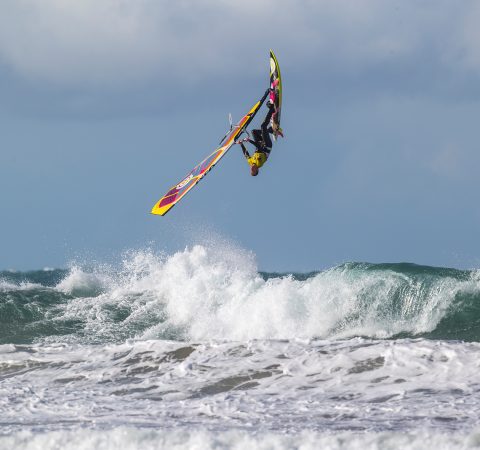
ANDY KING
I use 86 and 99 litre Goya Custom Thrusters and Goya 3.7, 4.2, 4.7, 5.3 and 5.7 sails. I’ve tried to simplify my board quiver as I used to find I’d be constantly chopping and changing too much to ever get really settled, so for the 2019 season I’ll just have 2 boards – 99 and 86 litre Goya Custom Thrusters. However for the Gwithian event I still had my previous 3 boards, a Goya Thruster One 105 litre, plus a 92 and 81 litre Custom Thruster and this confirmed my theory of it causing you to second guess your choices and led to me wasting time with a board switch from 92 to 99 in my last heat. Fortunately for me, Steve Thorp of K4 fins is good enough to supply me with a selection of his fins that have allowed me to tune my boards beyond the original production factory settings. I find I now ride a board with more volume but with less fin lift. This means I’ve got more volume to move about on in marginal or gusty conditions but that I don’t get over finned if the wind was to increase during a heat. As I am not winning events it’s hard to say if that’s a solid tactic, but it suits me for now. The higher volume board also allows me to use a slightly smaller / less powered sail which adds control and consistency for performing moves. After my layoff with an ankle injury I decided to swap from quads
to thruster boards. The thruster feels like it gets planing really quick and lets you take every jumping opportunity in a heat as the fin setup allows you to drive really hard into the take-off on ramps for better height. They ride very well but with the quad or twin setup it is that bit easier and less risky to spice up your riding in the very average wave conditions that frequently plague competition. Ultimately contest kit choice is a compromise if both jumps and waves are being scored. I love jumping so I’ll nearly always bias my kit to getting maximum air time, this has no doubt hindered my progress in riding and as a result limited my success in events, so don’t do it kids, but hey someone has to be the clown who entertains the crowds!! With hindsight I’ve also learnt that if you want to succeed in competition, even at national level, having an event caddy is essential. That extra pair of hands can save you masses of precious energy and time in what are very long and arduous days. I mean golfers have a caddy to carry a single bag of clubs, yet we are expected to rig 3 or 4 sails and then lug 2 or 3 sets of kit up and down the beach with the tide throughout the event period. Dave Horrocks is a prime example of not only a standout sailor in his own right, but also probably the best caddy I’ve seen with his support of his brother Phil Horrocks.
Whereas my brother will just go surfing or sailing somewhere else, as would I to be fair. So find a friend, a partner, a parent or a sibling and reward them for their efforts and you could be on your way to starting a successful team!
I’ve always stuck with a 5 sail quiver of 3.7, 4.2, 4.7, 5.3 and 5.7. Since riding for Goya I’ve found sails that offer me a perfect balance, with plenty of power to go fast and jump high but with a power that can be controlled and made neutral for wave riding potential way beyond my limits. There was a time I’d rig pretty much every sail, but as you get older and perhaps wiser, I will stretch to three rigs if the forecast is changeable and I have the time or just two if time is tight. Knowing and trusting a reliable detailed weather forecast source is another key tip. I find bigsalty.co.uk to be ‘the’ forecast of choice especially for here in the UK. UK designed, developed and lead by top windsurfer James Cox, what more could you want! Finally don’t forget wetsuits and wetsuit accessories, an essential part of any event quiver. You will often find yourself at the beach all day, often starting super early and finishing super late, all factors that mean you are going to be feeling the cold a lot more than during your average free sail. I’ve just switched to ION wetsuits and accessories as I struggled in the cold at the Gwithian event with the bitter north winds. I’ll make sure that I have at least two dry decent wetsuits when I start each event day as there can be a lot of waiting around in particular if you do well in a single elimination, or so I am told as it’s been a while. A rigging jacket, hood / hat and something to keep your feet warm are also beneficial to being in a fit state to perform. Ultimately that is what you are looking to achieve at the start of every heat. Having a board and sail setup that will allow you to perform in the conditions you get in that 12 minute heat and being physically able and ready to perform to the best of your ability for as many heats that are asked of you. Not everyone can do that, and that is why there are and always will be, exceptional free-sailors who will never gain the competitive success of other more focussed all-round performers.
“Contest kit choice is a compromise.”

TIMO MULLEN
I use Severne boards and sails and my board quiver is a 115 Dyno, 103 Nano, Mako 79, 84, 99 and 101, complimented by a quiver of 5.3, 5.0, 4.7, 4.5, 4.2, 4.0, 3.7 and 3.5 Blade sails and a 5.6 S1. I have been competing both at international and national events now for over 30 years, I have learnt the hard way that equipment setup is 50% of the battle. Having all my equipment ready to go and perfectly set up for when that heat starts really does make the difference between winning and losing! This means I need to be covered for any conditions from light wind float and ride, light cross-onshore jumping to full on balls to the wall nuclear winds. Fortunately Severne keep me kitted out in the best gear to cover all these conditions.
That said, I would be pretty disappointed if I was having to use my 115 Dyno in a contest as it means the conditions are pretty much the wrong side of contestable, but I know contest organisers can get desperate sometimes and guys a lot lighter than me can be planing on their wave gear and making conditions look ok. So, my Dyno always gets packed ‘just in case’; this board planes and jumps in hardly any wind, and teamed up with my 5.6 Severne S1, I can be competing in just 8-10 knots, plus even if the conditions are not contestable I still want to be on the water having some fun rather than sat on the beach! I’d use this board with 5.6-5.3 sails. My 103 Nano is a light wind onshore weapon; I came 3rd in Cornwall in 2017 on this board, set up as a quad this thing just rips. I could do frontside airs in bolt onshore with a 5.6! It’s extremely controllable for such a high volume board, I love it! Set up as a quad with Severne G10 110 fronts and 150 rears, I’d use this with 5.6-5.0 sails.
The 101 Mako is the only custom board in my van, 2 years ago I weighed 93 kg! So I asked James Hooper the Severne designer to make me a board I could use in no wind. He basically scaled up my 91 Mako into the 101; I ride it as a quad with 150 rears and 110 fronts. It goes really good in light winds, which really throws the judges as I’m one of the biggest guys yet I am out there trying to push for the contest to run when it is pretty light! I’d use this with 5.6-5.0 sails.
The 91 Mako is easily my favourite board ever! This board is insane, best piece of kit I have ever used, it is so easy to use! From side-onshore to perfect side-off this board has it all. I mostly ride this as a quad with either 150 rear fins or 140’s and with 100 fronts. I have used it as a thruster before when it is light side-on jumping, but I think ultimately this performs as a quad best. If I am feeling dubious about the conditions I will always choose this board as even when it is super windy it will still hold its line and rail. Did I mention I like this board!!! I use this with 5.6-4.5 sails.
Since I lost a lot of weight and now weigh in at 85 kg I have started to ride smaller boards more than I used to, and the 84 Mako has been a welcome surprise to me. It planes so early and is pretty floaty even when it gets super light. I started to try this board as a thruster setup with a new 17 cm thruster that Ben Severne gave me to try out and it is amazing in cross-on with this and 110 side fins. In the 2018 Cornwall contest the conditions were side-onshore with a lot of current, the PWA boys were saying it was basically a good version of Sylt. I used this all day and in fact for the entire contest set up as a thruster and managed to place 2nd on the onshore day, pretty good for a down-the-line wave board!! Normally I do use this as a quad though, riding it with 140 rears and 100 fronts. This board is also an amazing jumping board as it is very fast, especially as a thruster. I’d use this with 5.0-3.7 sails.
The 79 Mako is my luxury dream board, nowadays no one really tends to ride smaller boards in contests simply because in a 10 minute heat you want to be 100% sure you will be planing all the time! However, it can get really windy in the UK and especially some of the spots we compete in, like Tiree and ‘Rhossy’, so it is important to have a board that you know will not let you down when it gets crazy! My 79 Mako is exactly that. I ride this as a quad again, set up with 140 rears and 100 fronts. This board is so good, like butter smooth rail to rail turns even with a 3.7 maxed out. Like most good wave boards it also rips in onshore as the rails just hold your line with confidence. I have actually had my best day ever at Gwithian on this board, normally Gwithian is pretty awful when side-off and windy as the wave gets this huge chop on the face, but this board just cuts through the chop like a knife through butter. Surprisingly I can again use this board even when the wind drops off a bit. I don’t get to use this board much, but when I do I get a little bit excited and I’ll savour the day I can use it in a contest! I’d use this with 4.7-3.3 sails.
For sails I mostly use all Severne Blades, as they are just so light and powerful. I can be planing despite being heavier than a lot of the guys with sometimes the smallest sail. I really have noticed this a lot lately, might be because I have lost weight, but these sails really do get me going in not much wind. On the flip side as they are 5 batten they stay 100% in control when the wind picks up, which is really crucial in a heat as I would always choose to be more powered up in a heat than be underpowered. Landing jumps in a heat even though you may be totally overpowered is pretty important in a contest, so I find with the Blades I know they will still perform controlled even when I am stacked! For really light winds I use a Severne S1 5.6 as it rigs on a 400 mast, whereas the Blade 5.7 rigs on a 430, so it means I do not have to carry an additional sized mast around in my van all the time and during a contest I can quickly derig my 4.7 and rig my 5.6 on exactly the same mast and boom if I have to. I am fortunate to have enough masts to rig my entire quiver at once if I have to. At the BWA event in Southbourne for example I used everything from 5.6 to 4.0 in one day and was glad they were all rigged and ready! Preparation is everything at a contest, I like to turn up to the beach as early as possible, get a good convenient parking spot so I can see the conditions all day and use my van as a shelter between heats to stay warm and focussed on the job at hand. I tend to keep myself to myself during the day; I am pretty confident on the decisions I make with my gear, so I don’t like to get influenced by what the other riders are doing, plus they normally will stitch you up on telling you what the conditions are like!! I will always have all my food and water ready for the day and have some sort of snack such as nuts or a banana always in the pocket of my de rigueur ‘DryRobe’.
My biggest mistake when competing – windsurfing too much! Yup this is my downfall in contests, if it is good conditions I want to be out there all day, that fire burns inside me whatever, but also I think it is because I do not travel so much these days to train, so any time on the water is important. I am usually first and last on the water at a contest, but that is simply the frother in me wanting to get out there and enjoy it, not so good though when during a heat you realise you are exhausted as you have already sailed for 3 hours!!
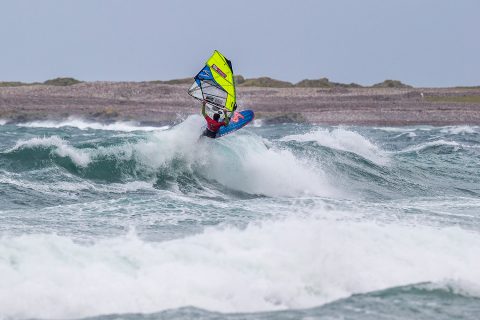
PHIL HORROCKS
These are the boards I use:
Simmer Quantum 80 – for when the wind is super strong and particularly gnarly! I rarely use it these days though as the new Simmer Cortex line is my new go-to board.
Simmer Quantum 84 – I use it for all wave conditions on sails 4.0 to 4.7 – my most fun board, I love it!
Simmer Quantum 90 – my board for when it gets a little lighter, 4.2 to 5.3, or it’s a bit more onshore and I want to carry extra speed if the waves are fatter. My most used board.
Simmer Quantum 99 – Big Bertha to me! Has a few extra litres for float and ride or light conditions, amazingly manoeuvrable for a big board!
For sails I use Simmer Blacktips, sizes 3.7, 4.0, 4.2, 4.5, 4.7, 5.0, 5.3 and 5.6, all on Simmer SX10 masts with carbon Chinook RDM booms and extensions and bases to stick it all together – a great setup! For competition I try to make sure I have everything with me for a start! It is so frustrating if you see the forecast is 35 knots and you think ah, there’s only a small chance I won’t be on my 84 litre and a 4.2, but I’ll bring sails up to 5.0 in just in case, and my 90 litre board to be sure. Inevitably the forecast switches, the direction takes a wobble or it’s squally and suddenly you’re in that moment thinking why did I not put in the 5.3 or the 99 litre as your slopping around in the surf. I used to rig everything, pretty much, four or five complete rigs ready to go, clipped up to three boards, each day there was wind, even if the forecast was marginal. I think it was as much about a feeling of going through a routine of preparation that helped set me at ease. Now I’m much more laid back and will rig 2 or maybe 3 sets of gear at the most. I’m happy if I’ve got the one sail size I actually need and one size either side of it sleeved and pretty much ready to go. I try to treat it more like free sailing now. You have a pretty good idea what to expect with the quality of weather forecasts we have these days.
I don’t really tune my gear all that much to specific conditions anymore. Once I set up my new boards and I’m happy with them, that’s how they stay for the year. I tend to go fins in the middle, mast base in the middle, and then footstrap stance as wide as it will go, then it’s up to me to adjust to the conditions! It’s a super nice feeling to have boards that you feel dialled into, so I don’t mess with them! For downhaul I set and leave it. Occasionally I’ll adjust the outhaul for a little more power or control, but never more than 1 or 2 cm in or out. The boom itself might come down a shade if it’s strong and jumping conditions, but again max 2 cm from the norm. You don’t want to mess with a solid reliable setup.
“For competition I try to make sure I have everything with me.”
- Click to enlarge


